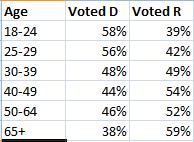
Arnold cites Karl Smith’s “demographic data that support my last-stand-of-the-WORST pre-mortem of the election.” But even on a naive extrapolation of Karl’s data, this “last stand” will last decades:
Democrats only won the two youngest age brackets. In twenty years, they’ll be in their thirties and forties – and by Arnold’s logic, their elders in their fifties, sixties, seventies, and beyond will still be Republicans. And who knows how new young voters will align themselves in the 2030s? For all we know, we’ll see a re-run of the 1980s, when young Republicans horrified their boomer parents.
I freely admit that one-party democracy is possible. I’ve blogged on one-party democracies extensively in the past (here, here, and here for starters), and even been quoted on the matter by the Law Minister of Singapore. But virtually all examples come from polities with relatively small and highly homogeneous populations. The odds of one-party democracy arriving in a diverse, divided nation of 300 million people are remote indeed.
I’ve bet against it before, and I’ll bet against it again. In fact, I’ll happily repeat my bet with Arnold for any future ten year period in American politics he cares to name.

READER COMMENTS
Hyena
Nov 5 2010 at 1:10am
I don’t think the city model is necessary here. Japan, for example, was dominated by the LDP from 1955 to 2009.
I suspect that prestige is the central issue: every time you see a one-party democracy, you will also find that the key players in the country’s struggle for independence/freedom consolidated into a single political bloc.
In cities this is probably quite simple: any unusually strong run of elections will produce a cadre of important people already so consolidated.
Peter
Nov 5 2010 at 1:13am
I would like to see that broken down by demographic for the past fifty or so years .. my guess is it’s not so much a WORST thing like you are thinking but an age thing. A friend of mine said something once to me many years ago (which also explains things like the hippies becomes crazy conservatives):
“If you don’t vote Democrat when you’re 20, you have no heart. If you don’t Republican when your 40, you have no brain”
My guessing is the fact that people naturally get more conservative as they age (and that cuts across ethnicity/culture/gender) figures more into this than WORST.
Zac Gochenour
Nov 5 2010 at 2:34am
Not that he’s likely to take me up on it, but I’d make the same bet with Arnold at 5-to-1 odds.
Robbie
Nov 5 2010 at 4:57am
If you assume that political views do not change over time then how do you explain the fact the the USA wasn’t a Republican one party state in the recent past?
Was there a strongly Democrat age group that has just expired leaving the 65+ strongly Republican? Seems unlikely to me.
jb
Nov 5 2010 at 1:18pm
IMO this is just silly. People change preferences over time, they become more conservative as they age and the benefits of openness decrease relative to the costs. This is a well-known issue.
In parallel, children are partially self-defined by how they differentiate themselves from their parents. “I’m not going to be a bigot about X like my dad”
So no matter what we opinions we hold, our children are going to hold some that are meaningfully different. For example, if I think that it’s ok for 5% of the citizens to live below $30k/year, my children might think it’s only ok for 2% to live below $30k/year
And eventually the Republican party will center itself around “5%” and the Democrats around “2%”. The parties go where the voters are.
In other words, I expect that the Republican party of 2040 will be a lot more liberal in 2010 terms than the current Republican party. But those people will still identify themselves as conservative, because, relative to their peers, they are
Jacob Oost
Nov 5 2010 at 2:11pm
How likely a person is to vote GOP was also correlated pretty well with income. A great many if not most of the “conservatives” and the like I’ve talked to used to be Democrats or outright leftists. It could be that maturity and income (i.e. how much stake you have in tax policy) decide whether a person votes frivolously or seriously.
Comments are closed.